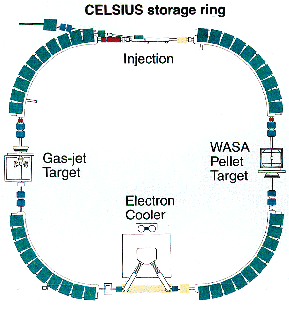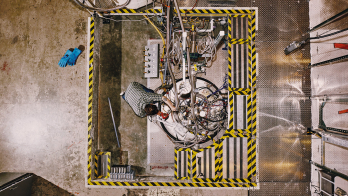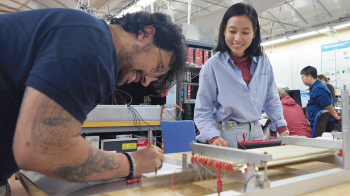
During the recent PANIC99 particle/nuclear physics conference, CELSIUS/WASA, a new detector facility for the CELSIUS cooler storage ring, was inaugurated. The inauguration talk was given by Erwin Gabathuler and the facility was shown to conference participants during tours of the the Svedberg Laboratory a Swedish national facility for accelerator-based research.
The name of the laboratory is associated with Svedberg, the 1926 chemistry Nobel Laureate, who in 1945 took the initiative to build the Gustaf Werner 185 MeV synchro-cyclotron that was, in the early 1950s, the highest-energy accelerator in Western Europe.
This accelerator, rebuilt into a sector-focusing synchrocyclotron, is used for research and also serves as an injector for CELSIUS (Cooling with Electrons and Storing Ions from the Uppsala Synchrocyclotron), which is an accelerator and storage ring intended for internal target experiments.
The magnets for the 82 m circumference CELSIUS ring formerly used in the CERN g-2 experiment (to measure the muon’s magnetism) and ICE (beam cooling) experiment were brought from CERN to Uppsala in 1983. CELSIUS experiments began in 1990. There are two target stations. One is occupied by CELSIUS/WASA and makes use of protons with energies of up to 1.36 GeV.

The CELSIUS/WASA collaboration involves groups from Uppsala, Stockholm, Hamburg, Tübingen, Jülich, Warsaw, Moscow, Dubna, Novosibirsk, Osaka and Tsukuba. Studies will be made of decays and production of light mesons from inelastic protonhydrogen collisions. CELSIUS/WASA consists of a forward part, primarily for measurements of the scattered protons, and a central part for measuring the mesons and their decay fragments. The targets are hydrogen pellets injected at high speed (60 m/s) through a tube that connects to the CELSIUS beam tube. They are produced from a liquid jet broken up into droplets by a piezoelectric crystal at the nozzle. The stream of 0.03 mm diameter pellets can be collimated so that the desired size and frequency are reached at the circulating proton beam.
One key component is the very thin superconducting solenoid coil, which is a further development of airborne magnets for Japanese space experiments. Copper of 3 mm thickness, corresponding to only 0.18 radiation lengths, is placed inside the caesium iodide calorimeter barrel, which has 1012 individual elements. Inside the solenoid are a plastic scintillator barrel with 146 elements and a mini drift chamber with 1738 individual straws. The trigger system has to cope with a total event rate of 10 MHz.
Already, several years of production experiments, with only the forward part of WASA, have provided interesting new information on meson production near the kinematical threshold. These measurements will continue, and studies of rare eta decays are being initiated. Of main interest are suppressed electromagnetic decays and strong decays. These will be used to measure limits of C and CP symmetries and their relations to the corresponding symmetries in the kaon system.
Understanding low-energy phenomena in terms of quarks is one of the great challenges of subatomic physics. The rare decay processes may also unravel surprises that are not easily explainable by the Standard Model.








